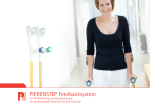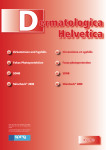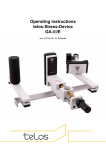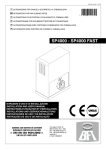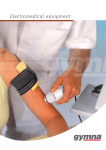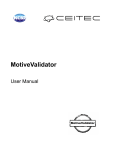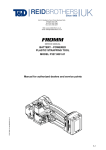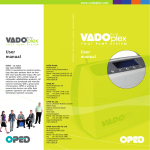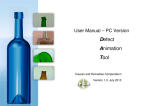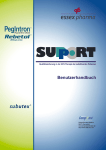Download Follow-up treatment booklet foor
Transcript
Torn cruciate ligament Joint replacement TEP knee Joint replacement TEP hip Fractured or sprained foot Fractured or sprained hand Everything your foot needs Our feet What makes you susceptible? They do what we want them to: They lift up, lower themselves, stretch out. And over the course of a lifetime they carry us more than 160,000 km. A large proportion of bone fractures are caused by the exertion of external forces, in car accidents, during sport activity or falls during leisure or work time. Our feet are miracles of nature, and ingenious all-rounders. We can run, walk and jump with them. They carry our bodies and help to stop and move them. Some of us take over 5 million strides each year - no, not someone like a marathon runner. We cover this distance just with normal everyday activity. In everyday situations, uneven floors, stairs or sidewalk edges often hide potential dangers. All that can change within a tenth of a second. One trip, one fall, an accident - and everything that was taken for granted before suddenly no longer functions. If the force exerted from outside is larger than the bone elasticity, the bone will fracture. Depending on the strength, direction and speed of the force being exerted, the fracture may be simple or more complicated. Anatomie of the foot Fibula Shin-bone (tibia) Syndesmosis Achilles tendon Outer ankle (malleolus) Lateral ligaments Heel bone Upper ankle Ankle bone (talus) Navicular bone (naviculare) Metatarsal (Metatarsals) Toe bones (phalangeal bones of the foot) Fractures to the foot and ankle Injuries to the foot and ankle are among the most frequent injuries of all. Since more than a quarter of the bones in the human body are located in the feet, such injuries are very varied and often involve the joints in-between. Fracture of the outer malleolus is caused by the foot becoming twisted. In most cases the ligaments of the ankle are also affected. Typical signs of a fractured ankle are strong pain when there is pressure or movement, as well as swelling, and sometimes visible bruising above the inner and outer malleolus. Ankle/outer malleolus Feet Between 40,000 and 50,000 fractures of the upper ankle occur each year in Germany. This is 10 percent of all fractures. They usually occur through indirect trauma (twisting), and less often through direct trauma. A fracture of the outer malleolus is, along with knee injuries, one of the most frequent sports injuries. Elderly people suffer more often than young people from a fracture of the outer ankle. The main causes of a fracture to the foot are an accident on an uneven surface, a fall or a sports injury. Jumps from a height, such as from a ladder, may result in a sprain or a fracture of the heel bone. Distortion / Sprain Torn Achilles tendon A sprain or distortion occurs when the joint structures are pushed against each other. This displacement occurs when a force is applied which pushes apart the joint surfaces more than normal. But this displacement is only temporary. Once the application of force ends, the joint structures return to their initial position. The classic Achilles tendon rupture is usually caused by damage from overload in dynamic sports activity. Pains and swelling are the typical signs of a distortion. Pulling apart the joint surfaces for just a short time can cause considerable injury to the joint capsule and to the ligament apparatus. Symptoms can vary, depending on the severity of the injury. As a consequence, an Achilles tendon rupture is suffered most frequently by those involved in active sports. There is a predominance of injuries in men between the ages of 30 and 50 who actively pursue sport. When the Achilles tendon is torn, this is an indirect trauma, which feels like a blow or kick against the heel. Often the patient feels a sharp pain, as if stabbed with a knife, which is often accompanied by a loud bang. At the point of the tear a bump can initially be felt, and standing on the toes is no longer possible. The most common tear site (90% of cases) in spontaneous ruptures is the so-called tendon, which is located some 2-4 cm above the connection on the heel bone. Diagnosis and treatment The description of how the accident happened provides the physician with the first clues about the injuries. A precise diagnosis is usually made only after the X-ray examination. Depending on the type and location of the fracture, the physician selects the appropriate treatment method. In the past, fractures were immobilized for lengthy periods with a plaster cast. Now the bone parts are often fixed with screws, plates and then protected with VACO®ped. The advantage of the current approach is that it takes less time before the patient can put weight on and mobilize the injured body part. A conservative treatment, that is without surgery, is only to be recommended if the anatomy of the foot is not impaired or altered. In this case, only VACO®ped (previously a plaster cast) is applied. The splint immobilizes the foot or the joint for the next few weeks. If a conservative treatment is not possible, surgery must be performed. After surgery, the foot is also immobilized with VACO®ped. Surgery or not – you, yourself, can do a number of things to ensure that the healing process is fast and successful. Your steps towards recovery PHASE 1 Surgery is over but you are still recuperating! PHASE 2 PHASE 3 PHASE 4 The first step is always the hardest, but it gets easier! The biggest hurdle has been overcome – it's time to get back to normal! I can be active again – if I want to! How to find your way in this brochure Description of each of the phases PHASE x Objective Phases In the following weeks you will pass through various phases during rehabilitation. You can find these here. Objective Duration Your physician will recommend to you the order, duration and frequency of the measures in your individual treatment plan. Each phase of the rehabilitation program contains different objectives. You can see here which objective you can reach in the respective phase. Measure Measure Behandlungsrichtlinien in Zusammenarbeit mit Prof. Dr. N. Haas, Unfall- und Wiederherstellungschirurgie Charité Berlin Behandlungswoche 1 2 3 4 5 Unfall- und Wiederherstellungschirurgie 6 7 8 9 There are appropriate measures to help you when you aim for these objectives. 10 Weber A 0° Weber B operativ Weber C/ Maisonneuve 0° -10° +10° 0° 0° 0° -10° +10° 0° 0° -10° +10° Pilon-Tibial Calcaneus operativ Calcaneus konservativ 0° -10° +10° -10° +10° 0° -10° +10° -10° +10° 0° Belastungssteigerung nach Röntgenbefund Belastungssteigerung nach Röntgenbefund -10° +10° 0° Metatarsal Belastungssteigerung nach Röntgenbefund VACO-pedes 0° Laufsohle 0° Jones Fraktur 0° VACO-pedes Entlastungssohle 0° -10° +10° 0° Belastungssteigerung nach Röntgenbefund 0° 0° Achillessehne operativ/konservativ 30° Entlastung/Sohlenkontakt You can read here which measures will help you to achieve the objective more quickly. Belastungssteigerung nach Röntgenbefund -10° +10° Arthrodese OSG 15° 15° Lagerung Lagerung im VACOsplint 0°/15°/30° Immobilisierung mit 0°, 15° oder 30° Fix-Adapter (dorsal und ventral) Teilbelastung Vollbelastung OPED GmbH Orthopädische Produkte Mühlbachweg 2 . D-83626 Valley Tel. 0 80 20 / 90 79-0 . Fax 0 80 20 / 90 79-99 e-mail:[email protected] . www.oped.de 0° -10° +10° Physiotherapie -10° +10° Beweglichkeit Freigabe OSG mit ROM-Adapter (dorsal und ventral) WM-BHRL-15-3 Arthrodese USG -10° +10° 0° Hallux PHASE 1 Surgery is over but you are still recuperating! PHASE 1 Surgery is over - but you are still recuperating! Objective Pain relief Your objectives in this phase: Reduction in swelling · Pain relief · Reduction in swelling · Wound healing Wound healing The period after surgery is considered by the physician to be very crucial, because patients tend to overload the foot in this phase. Apart from the exercise phases, you should rest the leg concerned in the first few days after surgery. Keep your leg elevated and use the measures to relieve swelling and pain. Please also read the following pages concerning this. Measure Avoid getting up and walking around frequently, as well as sitting for a long time with the legs hanging down. Because this leads to an increase in swelling and pain again, which can delay the rehabilitation. For this reason, you should slow down until the second phase begins - about 10 days after the OP / injury. "The winner is decided at the finishing line, not in the first few meters…“. PHASE 1 Objective "Boys don't cry" - you probably remember this saying from your childhood. But after surgery it is usually not sensible to "endure" the pain. Pain refief Caution Danger of thrombosis! If the body feels pain, the muscles restrict certain movements and thus "lock" joints, which can lead to problems later on. For this reason you should not be afraid of taking pain-killers for a short phase after surgery. This will help to prevent chronic fibromyalgia from developing. Ask your physician for a preparation suitable for you. In addition, drugs are also used to inhibit inflammation and to stabilize the mineral and electrolyte balance. If you notice the following signs, contact a physician immediately! The progression of thrombosis can be fatal! · Muscle aches and pain in the calves · Complaints increase when standing, decrease when lying down · Increased veinous markings of the surface veins (bypass circulation), especially on the front of the shin · Feeling overly warm · Stretched, glossy skin · Pressure pain in the calves (Lowenberg sign) · Pain in the calves when lifting foot (Hohmann sign) Measure Drugs PHASE 1 Surgery is over - but you are still recuperating! Objective Pain relief Cold reduces nerve activity, which causes pain relief. Limited cold stimulation of up to 5 minutes causes a narrowing of the vessels and a slight rise in blood pressure. Important to know: ice does not reduce swelling - it only stops it from occurring or from increasing. But it does have an anti-inflammatory effect and relieves acute pain. For this reason you can use ice selectively after loads or to reduce pain. Cooling - but not ice-cold! This is the principle of the so-called cryotherapy, which is used to relieve pain. And this is how it works: The temperature that is applied to the skin should be between 6 and 8 °C (hot ice), and this should not be applied for more than 12 minutes. Then 3 minutes of room temperature is required. This change should be made several times. The necessary cooling can be achieved with icy water, but also with appliances that keep the water at the optimal cooling temperature. Some appliances combine cooling with pulsating compression. This method has proven to be especially effective. Measure Cryotheraphy Hot ice PHASE 1 Objective The lymphatic backflow is still disrupted after surgery. This means: the body cannot yet regulate the tissue fluids "normally", so that swellings may occur, especially after loads. Reduction in swelling You should often put your feet up during breaks. This helps to reduce the pressure that exists in the tissue concerned. This can simply be done with cushions, but also by using braces, and best in combination with slight movement. With the help of the lymph vessels, tissue fluid from the soft tissue is transported away and into the blood vessels. If the lymph system is disrupted in its function, body fluids may collect in the tissue and swelling may occur (edema). Measure Lymph drainage is an appropriate means of restoring the balance that has been disrupted. Lymph drainage also stimulates the immune system. Putting feet up Lymph drainage An appropriately trained therapist can stimulate lymph drainage. Alternatively, there are appliance systems that use compression sleeves to stimulate lymph drainage. PHASE 1 Surgery is over - but you are still recuperating! Objective Stabilization Mobilization With VACO®ped you have received a modern medical device to help you in your daily activities. We would like to give you some tips to help you in the handling of VACO®ped and to speed up your recovery. You can find more detailed information on usage in the user manual. A vacuum cushion ensures an optimal fit to the shape of your foot and ankle. If irritating pressure points should develop, or the cushion no longer fits, you can re-adjust the vacuum cushion (see user manual Chapter: Valve functions). VACO®ped Behandlungsrichtlinien in Zusammenarbeit mit Prof. Dr. N. Haas, Unfall- und Wiederherstellungschirurgie Charité Berlin Behandlungswoche 1 2 3 4 5 6 0° Weber B operativ Weber C/ Maisonneuve 0° You can find much more information, as well as a video user manual, at www.vacoped.com. 7 8 9 10 -10° +10° 0° 0° 0° -10° +10° 0° 0° -10° +10° Pilon-Tibial The timeline these adjustments for weight bearing and physical therapy has been set forth by your physician. Be sure to discuss the details of your protocol you’re your doctor. Unfall- und Wiederherstellungschirurgie Weber A Calcaneus operativ Calcaneus konservativ 0° -10° +10° 0° -10° +10° 0° 0° Metatarsal -10° +10° -10° +10° Belastungssteigerung nach Röntgenbefund Belastungssteigerung nach Röntgenbefund Belastungssteigerung nach Röntgenbefund -10° +10° VACO-pedes 0° Laufsohle 0° Jones Fraktur 0° Hallux VACO-pedes Entlastungssohle 0° Arthrodese USG -10° +10° 0° -10° +10° 0° Belastungssteigerung nach Röntgenbefund -10° +10° Arthrodese OSG Belastungssteigerung nach Röntgenbefund 0° 0° Achillessehne operativ/konservativ 30° Entlastung/Sohlenkontakt 15° 15° Lagerung Lagerung im VACOsplint 0°/15°/30° Immobilisierung mit 0°, 15° oder 30° Fix-Adapter (dorsal und ventral) Teilbelastung Vollbelastung 0° -10° +10° Physiotherapie -10° +10° Beweglichkeit Freigabe OSG mit ROM-Adapter (dorsal und ventral) OPED GmbH Orthopädische Produkte Mühlbachweg 2 . D-83626 Valley Tel. 0 80 20 / 90 79-0 . Fax 0 80 20 / 90 79-99 e-mail:[email protected] . www.oped.de Fig. Treatment guidelines WM-BHRL-15-3 Measure Adjusting the ankle joint position and releasing the hinges to enable mobility can be done with the help of the yellow key and the adapters (user manual Chapter: Assembling the Adapter). PHASE 1 Objective Wounds heal in different ways. The healing process and the scar formation associated with this is dependent on one's age and personal constitution, on the localization and degree of severity of the tissue injury, as well as on the treatment and care. Skin with poorer circulation, which is thin and dry, will require longer to heal, but will heal with less scar formation. Younger people tend to produce more tissue than necessary when they have injuries. Because of this, larger and thicker scars often subsequently occur. A selective scar treatment can prevent this. In the first weeks after surgery the scars should be left alone. Under no circumstances should you scratch the scab off. Wound healing It is best if this falls off on its own. But you can also gently remove the scab with a special wound-cleansing agent. Only when the wound is closed and wellhealed should you take care o fit yourself. Keep the tissue around the wound supple through damp compresses and an ointment. Measure Scar care Every open wound (as long as there is no connective tissue occlusion through new skin growth) represents an infection risk. Therefore the wound should always be covered with a bandage to prevent it from getting dirty. Through scar care, you will not only achieve better cosmetic results. The tissue around the closed wound will become more elastic and also more load-resistant. The wound should be prevented from contact with water during daily hygiene routines. Use a washcloth or cover the wound with a watertight bandage. You can even take a shower in comfort. PHASE 1 Surgery is over - but you are still recuperating! Objective Load Walking Walking with crutches requires some practice at the beginning. Here are some tips to help you cope better: The height of the crutches should be adjusted individually. The handle height should be adjusted so that it is at the height of the wrists when standing up straight and holding the hands down to the sides. 3-point walk with crutches 1 Starting point 2 Place the two lower arm supports one step length in front of you, the injured leg should also move forwards (root of foot at about the level of the line connecting the two supports). 3 Move your weight onto the supports and set your healthy leg one step in front of the injured leg. Measure Gait training Make sure that you roll over correctly! Then move your weight to the good leg and repeat the process, as shown in Figures 2 and 3. PHASE 1 Objective Walking with crutches requires some practice at the beginning. Here are some tips to help you cope better: Load Walking Going up stairs Put your good leg one step higher, then place the crutch and the injured leg next to the leg already put forwards. Going down stairs First put the crutches, together with your affected leg, one step lower. Only then should you place your good leg on the same step. Measure Gait training PHASE 2 Surgery is over but you are still recuperating! PHASE 2 Surgery is over - but you are still recuperating! Objective Strenght Phase 2 begins some 10 days after your surgery or injury. You should wait at least until the stitches have been removed. Endurance Your objectives in this phase: · Retaining the mobility of healthy joints On the following pages you will find gymnastics exercises that you can do at home in the early phase after surgery. The load-bearing capacity is different for every patient and depends on the constitution and general level of fitness, among other factors. This is why there are no specific repeat details for most of the exercises. Measure It is important that you exercise for at least half an hour each day. Do each exercise for about one minute. After a short pause, repeat the sequence of exercises two to three times. The following basic rules apply for all the exercises in this brochure: · If you are in pain, stop the exercise immediately! Then try out a different exercise or take a break. If you are unsure whether the exercise is suitable for you, ask your physician or physiotherapist. · The exercises have been chosen so that other joints and muscles in the entire mobility chain are also exercised. This is important in restoring harmonic movement sequences. · Always start your phase 2 training sessions with coordination exercises, since these must be performed at full concentration. You can then perform strength and endurance training. PHASE 2 Objective Scar massage Fig. lattice fence massage A scar massage causes strong blood circulation in the area of the scar and the dissolution or loosening of adhesions in the connective tissue. The massage strokes described below should be carried out quickly and about 5-10 times each: Start by moving around the scar tissue, as illustrated above. Then make diagonal strokes with one finger in a "mesh pattern" (like lattice fencing) across the scar tissue. This is done in two stages: First massage all parallel running diagonal lines in one direction (repeat each stroke 5-10 times). After this, massage the lines that cross in the other direction (see figure). The massage is followed by stroking gently and broadly over the scar and the surrounding tissue. Wound healing The application of appropriate active ingredients can reduce the occurrence of scars to a considerable degree. The active ingredients contained in scar ointments, such as allantoin, dexpanthenol and urea, make the tissue soft and supple. A number of healing ointments also contain ionized trace elements and electrolytes, which support the healing process of the skin and reduce scar formation. You can apply such an ointment just a few days after the wound has closed. This helps to prevent an ugly scar from forming. But existing scars can also be treated. The active ingredients work directly on the scar tissue and stimulate regeneration back to a normal skin structure. Apply the ointment or gel to fresh scars 1-3 times per day. Massage the ointment gently with your fingertips from the center of the scar to the outside, until it has fully penetrated the skin. Visible success will only be achieved, however, if you continue the treatment consistently over a period of up to six months. Measure Scar massage PHASE 2 Surgery is over - but you are still recuperating! Objective Strenght The interaction of hip and knee Endurance Place yourself in the all fours position on a training mat. Support yourself here with your lower arms rather than your hands. Lift up the affected leg and simultaneously stretch it upwards. Stretch it out as far as you can, so that knee and hip are fully stretched. Make sure that your pelvis remains horizontal and parallel to the floor, and does not twist. Leg and spinal column form a slanting line upwards. Try and prevent your back from becoming too hollow. Measure Strengthening exercise Stop stretching and move your leg slowly back again, but keep it above the floor. Repeat this movement a number of times, without putting your foot PHASE 2 Objective Strenght Exercise for stretching and strengthening the hips Endurance To go a step beyond the previous exercise, you can use an elastic training band, as shown in the illustration.. Measure Strengthening exercise PHASE 2 Surgery is over - but you are still recuperating! Objective Strenght Endurance Exercise for stretching and strengthening the hips Lie on a training mat, prop up your head. The unaffected leg lies at a slight angle on the floor. Attach an elastic training band to the other foot (with VACO®ped) so that your leg is pulled slightly forwards. The band can be attached to a table leg or attached to the door frame with a special anchor under the door. Measure Strengthening exercise Pull the elastic band with the outstretched leg upwards and at the same time slightly backwards. The toes should point to the front when doing this. Then move your leg back again, but keep it above the floor. Repeat the exercise several times. You can gradually increase the number of repetitions. A few training sessions for your good leg will certainly do it no harm. PHASE 2 Objective Strenght The interaction of hip and knee Endurance Lie on your back with arms outstretched next to your upper body. Raise your buttocks and stretch the leg with the VACO®ped forwards into the air. Now move the raised leg with the knee towards your head and back again. The leg is bent here and then stretched out again. Try and keep the pelvis in a stable position. Repeat the movement sequence several times. After a short rest, do the exercise again. Measure Strengthening exercise PHASE 2 Surgery is over - but you are still recuperating! Objective Strenght Strengthening the quadriceps Endurance Attach an elastic training band using a special support on the upper edge of the door. Pull the band with the relevant leg back so that hip and knee are fully stretched. Move only the leg when doing this. Try and keep the upper body as still as possible. Measure Strengthening exercise PHASE 2 Objective Strenght Strengthening the rear side of the thighs Endurance Sit down in a sturdy chair (not an office chair or other types of movable seats). Hold the seating surface tight with both hands. The affected leg is attached to the training band and stretched forwards. Now bend your leg until your foot is on the floor. Slowly stop resisting the pull of the training band until your leg is stretched out again. Repeat this a few times using smooth movements. Measure You can also do this exercise with your good leg. Strengthening exercise PHASE 2 Surgery is over - but you are still recuperating! Objective Strenght Strengthening the rear side of the thighs Endurance Lie on your stomach on a training mat. Support your forehead with your hands, so that your head does not need to turn. Attach the elastic training band to a table leg or door frame using a special anchor. Pull the band with the affected leg upwards by bending the leg. Let your leg fall slowly down again. Avoid any jerking movements when doing this. This exercise can also be done with both legs. Measure Strengthening exercise PHASE 2 Objective Strenght Mobilization of the lumbar-pelvis hip region Endurance Walking with crutches can lead to muscle tension in the lumbar-pelvis-hip region, which causes back pain in many patients. This exercise can help you to avoid tension, or be of help if you are in pain. Bend the leg with the VACO®ped upwards. With the opposite hand, move it slowly downwards on the mat, as shown in Figure 2. Remain in this position for a few seconds before repeating the exercise. Measure It is important here that the shoulder and arm on the other side remain on the floor. If possible, turn your head as well in the opposite direction. This will stretch the whole region from the lumbar to the hips. To vary the stretching, you can place the leg at different angles. This will make the exercise even more effective. Do this exercise on both sides as well. Strengthening exercise PHASE 2 Surgery is over - but you are still recuperating! Objective Mobility Rump Stabilization with gymnastic ball Kneel down on a training mat and lay your upper body on a gymnastic ball. Attach a training band with two handles to a table leg or the underside of the door. Now with both arms simultaneously, pull the training band as far back as possible. Your hands should now be at about the same level as your ear lobes. Allow your arms to be pulled by the band and move your arms back to the front. Try to hold your arms slightly bent when doing this, rather than completely stretched. Measure Strengthening exercise PHASE 2 Objective Strenght Rump stabilization lying on your stomach Endurance Lie on your stomach on a training mat and slightly raise your upper body. Your head should be bent down slightly, and you should keep your neck straight if possible. Now also slightly raise your arms, which are bent sideways. Try to keep your hands slightly higher than your elbows when doing this. Move your raised arms to and fro, as shown in the illustration. Your feet should remain on the floor as you do this. Perform this movement continually for at least 30 seconds before lowering your arms and upper body. After a short rest, repeat the exercise once or twice. Measure Strengthening exercise PHASE 2 Surgery is over - but you are still recuperating! Objective Strenght Endurance Variations on rump stabilization lying on your stomach Variation 1: Once you have mastered the basic exercise, you can heighten the training effect by exercising with weights. Two plastic bottles can be used for this, for example, which you initially fill with a little, and later with more water. Measure Variation 2: Strengthening exercise Here you move your arms in opposite directions. While you push one arm forwards, pull the other one back. As in the basic exercise, arms, head and upper body are slightly raised during the entire sequence of the movement. Your feet should remain on the floor. PHASE 3 The biggest hurdle has been overcome – it's time to get back to normal! PHASE 3 The biggest hurdle has been overcome – it's time to get back to normal! Objective Increasing the load to full capacity Improving the general condition Measure The critical phase has been overcome. You are now faced with the following objectives: · Step-by-step increase of the load until you can walk freely. · Improvement of your general condition and mobility. Training, performed right from the beginning, is increased continuously. You will feel increasingly assured in your movements. PHASE 3 Objective You should take a few days when transferring to walking without crutches. You can discard your crutches once you can walk normally, without limping. At the beginning you should only attempt short stretches (e.g. in your home) without crutches. As you become more assured you can walk longer stretches without crutches. If you feel very unsure at the beginning, just turn the crutches around, hold them in front of you in your hands, and use them as walking sticks. This increases the load without removing support entirely. Full load Walking with just one crutch is not recommended, since it delays a "limp-free" gait. You should therefore use both supports until you can walk without any support. Measure Gait training PHASE 3 The biggest hurdle has been overcome – it's time to get back to normal! Objective Pain relief Reduction of swelling You should immediately reduce the load on the leg if pain, swelling and/or a warming of the tissue surrounding the joint should occur or increase. A cottage cheese compress reduces swelling, is anti-inflammatory, relieves pain and is pleasantly cooling. · Spread the cottage cheese about 0.5 cm thick on a compress or a cloth and cover the treatment area liberally. To avoid infection it is essential to cover the wound with a watertight bandage. · The cottage cheese should be cool but not ice cold and left to soak in for about 15 minutes or until it has become warm/dry · Repeat if necessary If these symptoms occur after the load, you should react immediately with Measure Ointment · 15 to 45 min. of cryotherapy (for selective use of cold for pain relief. see phase 1). · Ointment dressing Cryotherapy · Cottage cheese compress Quark compress PHASE 3 Objective EMS is the abbreviation for electrical muscle stimulation, a therapy to restore normal muscle function after immobility or injury. Gentle electrical impulses cause the rigid muscles to contract (tighten), thus helping them to gain more strength. If you use this method, make sure that the electrodes are correctly attached, as shown in the figure. With an appropriate electrotherapy device you can also strengthen other weak muscles in your body, loosen muscle tension or relieve pain using the TENS program (see Phase 1). Strenght Strengthening the lateral lower leg muscle (peroneus) Endurance The lateral lower leg muscles (peroneus) have the task of maintaining the stability of the ankle and preventing it from twisting inwards. After an injury to the ankle these muscles lose their reflex-like capacity to contract and a large part of their strength. For this reason it makes sense to specifically train the peroneus muscle using EMS equipment. Measure Electrotherapy (EMS procedure) PHASE 3 The biggest hurdle has been overcome – it's time to get back to normal! Objective Strength Endurance Mobility Strengthening exercise with gymnastic ball Lie on your back in front of a wall so that there is space for the gymnastic ball between your feet and the wall. With your affected foot, press the ball lightly against the wall, as illustrated in the first drawing. Now roll the ball up and down against the wall as illustrated in the second drawing. Measure Stabilization and balancing exercise Exercise with strong and even pressure on the ball. Once you can do the exercise you can increase the pressure applied. This can be increased until your pelvis is raised from the floor, which additionally trains your physical coordination. PHASE 3 Objective Strength Strengthening and stabilization exercise with training band Make sure that your knees are always pointing forwards so that your toes, knee and hip remain on the same axis. Endurance Attach the elastic training band to something at a medium height, such as a door handle or in the door frame. Sit on a chair with your good leg closest to the anchor point. Pull the band past your body with both hands, from one side to the other and back again. Try to keep the movement smooth and avoid any jerking movement. Sit still while doing this and only move your upper body. As a variation of the exercise you can later sit the other way round, so that the traction pulls from the other side. This increases the load on your leg. To make it more difficult, do the exercise sitting on a gymnastic ball. The best way to check your movements is to exercise in front of a mirror. Measure Stabilization and balancing exercise PHASE 3 The biggest hurdle has been overcome – it's time to get back to normal! Objective Mobility Stretching the thigh muscles Front of thigh and hip extensor muscle Stand in a walking position, with the affected leg to the back. Keep your upper body straight and push your hips forwards. The knee of your standing leg moves forward when you do this, the other leg remains as stretched as possible. Inner side of thigh Measure Stretching exercise You should stand on your good leg. The movement is in the direction of the arrow, until you feel a clear stretch on the inside of your thigh. Maintain this stretch for a few seconds. Rear side of thigh You already know this exercise from phase 1. Place the leg with the VACO®ped onto the seat of a chair. Lean your upper body forwards until you can feel the rear of the thigh stretching. Keep your back slightly hollowed. PHASE 3 Objective Strength Strengthening the posterior musculature Endurance For this exercise you need a robust chair and an elastic training band. Attach one end of the band to the back of the chair and the other end to your VACO®ped. Stand behind the chair as illustrated. Stand with your good leg on the training band. With the other leg, pull the band to the side and slightly to the rear. Try and keep the upper body still and straight when doing this. Extend your leg outward and then back a number of times, without touching the floor. Measure Stretching exercise PHASE 3 The biggest hurdle has been overcome – it's time to get back to normal! Objective Strength Rump stabilization Endurance Attach your training band at a medium height to the door. Sit on a gymnastic ball and support yourself with both legs firmly on the floor. You should hold the two ends of the training band at about eye height. Now pull the two ends of the band with your elbows bent at this height, and with both arms held out behind you as far as you can. Your back should go into a slightly hollow position. Make sure that you do not pull up your shoulders. Also try and keep your wrists quite straight. Measure Stretching exercise Then let the band pull your hands back and they will return to the starting position. Increase the number of times you repeat the exercise, depending on your state of strength and endurance. PHASE 3 Objective Mobilization To ease the transition to the next phase when you will no longer need your VACO®ped, it is recommended to utilize the ROM feature of your VACO®ped. The ROM adapter activates the hinges on the VACO®ped and allows you to walk with controlled range of motion. Through this your joints will slowly get used to normal movement again. Releasing the clips to enable mobility can often take place very early on, depending on the type of injury and the treatment. Ask your physician when you can make this switch. Step 1: Remove the front adapter Measure Step 2: Replace the rear FIX adapter with the ROM adapter Switching the adapters on the VACO®ped PHASE 4 I can be active again – if I want to! PHASE 4 I can be active again – if I want to! Objective Coordination Proprioception Proprioception is another term for the feeling of movement or deep sensitivity - that is, the interaction of the senses for posture, movement and force. Proprioception enables us to perceive the position (sense of place) and the movements (kinestesia) of joints and limbs. It is also an estimation of the necessary muscle power (sense of force) to maintain or change positions. It is therefore the requirement for coordinated movements and motoric reflexes. This movement control can be disrupted by various factors, such as injuries to the nerves, damage to the mobility apparatus (especially to joints, tendons, ligaments, muscles), and by immobility that persists for a long time. Measure If your motion sensors tell your brain that the surface on which you are standing is very slippery (e.g. ice), your leg muscles will create a different tension (you will move differently) than on a firm surface. If the pain and mechanoreceptors report that there is a disorder/injury in the joint (such as after an accident or an operation), this causes a restriction in movement. Your leg feels stiff and inflexible. With the following exercises you can maintain or restore your capacity for movement. But this will only work if you train regularly preferably on a daily basis. But how does this control of movements function? PHASE 4 Objective A trauma, or surgery, results in certain receptors no longer functioning or being removed entirely. This disrupts the interaction between the central nervous system and the muscles. The same thing occurs with immobility. The longer the joint is kept immobile, the greater the disruption. Coordination Receptors are special nerve cells which record stimulations and pass these on to the central nervous system. Each receptor is responsible for specific information. All this information is processed in the central nervous system and is used as the basis for reactions to disruption in our bodies. Proprioception Consequence: The readiness of the muscles to react is reduced. Movements, balancing ability and the coordinative ability of the body no longer function as smoothly as normal. Through selective coordinative training, your body can learn to compensate for these deficits. The remaining receptors take over additional tasks here. In this way the readiness of the muscles to react can be restored. Measure Coordinative training PHASE 4 I can be active again – if I want to! Objective Coordination Principle of coordinative training (mainly stabilization and balance exercises): Proprioception · Always begin your training session with coordination exercises. Begin the exercises slowly and carry them out as exactly as possible. · Exercise conscientiously and with full concentration. Move up from simple to more difficult movement requirements. · End the exercise if you notice that you are getting tired and can no longer fully concentrate. Move on to the next degree of difficulty only when you have mastered the more simple level. Measure PHASE 4 Objective Coordination Mobilization oft he ankle with the rocker board Proprioception This exercise helps to provide your ankle on the affected leg with more mobility. Move the rocker board to the left and right with your foot. Practice first in a sitting position, and later standing in a walking position (the good leg is standing on the floor). Make sure that the movement does not cause any pain in the ankle. Measure Mobilization training PHASE 4 I can be active again – if I want to! Objective Coordination Foot-ABC Proprioception Sit on a table so that your foot has no contact with the ground. Now write the alphabet with the affected foot. You can improve mobility in this way. Measure Mobilization training PHASE 4 Objective Coordination Increasing exercise for stance stabilization and balancing exercises In coordinative training, especially for stance stabilization, a wide range of variations are possible. Each variation means an increase in the training effect. Please observe the following principles when doing this: Exercise with bare feet. Step up the exercises slowly, from simple to more difficult movement requirements. Start, for example, with both legs on the floor, and increase the load by practicing in a walking position, later on one leg, and finally on the rocker board. Practice on less and less stable surfaces (stable floor to start with - then seesaw board horizontal - rocker board forwards/ backwards - rocker board side to side rocker board tilted - balance disc.). Practice first in a walking position (healthy leg on the floor, see figure), later with both legs on the board. Advanced students can also try it standing with one leg on the rocker board. Step up from exercises with much information (in front of mirror) to exercise forms with less and less information (without mirror - looking straight ahead - one eye closed - both eyes closed). Measure Increase the requirements only when you have fully mastered an exercise. Coordinative training PHASE 4 I can be active again – if I want to! Objective Coordination Stabilization exercise with gymnastic ball Practice first with your good leg in front, then change to the leg that has been operated on. Move your leg in this exercise so that the knee is always pointing straight in front. At the beginning, support your knee slightly with the hands, and later take your hands away. Measure Stabilization and balancing exercise Always perform the coordination exercises at the beginning of the training session with full concentration - strength and endurance exercises always after these. PHASE 4 Objective Coordination Leg axis training for a more stable stance For this exercise you need a rocker board with the tilting axis right/left. Here you may use your crutches for stability. As soon as you feel safe you can just discard the supports. To start with you can lessen the tilting movements by using a training mat or foam material. Measure Stabilization and balancing exercise PHASE 4 I can be active again – if I want to! Objective Coordination Stance stabilization with traction from the front Measure Stabilization and balancing exercise Start this exercise with both legs on the floor without a rocker board. Make sure that: the knees are slightly bent, the back is straight or slightly hollowed. Keep your arms stretched sideways and slightly forwards. Pull the elastic training band slowly backwards, as shown in the figure, and then move your arms evenly to the front. Step up the exercise according to the rules of coordinative training. Practice first with both legs on the floor, then in a walking position, and later in a walking position with rocker board and finally with both feet on the board (with tilting axis forwards/backwards). PHASE 4 Objective Coordination Stance stabilization on the seesaw board Proprioception Increase the exercises on the seesaw board step by step, as is the intention of coordinative training. Practice first standing with both feet on the seesaw board, then standing in a walking position (support yourself slightly with the toes of the rear foot) and finally standing on one leg. Measure Stabilization and balancing exercise PHASE 4 I can be active again – if I want to! Objective Improvement in everyday motor activity Transition to specific training Recovering "full use" of the leg is the objective of the entire rehabilitation phase. You should "feel fit" again and manage all movements without restriction. This is not restricted just to the leg that has been operated on, but refers to all your body. The principal objective of phase 4 is therefore to further develop strength and endurance, so that the resilience of the foot increases. Building this strength up is a slow but continuous process. Increase the exercise units step by step, from short loads to longer training sessions. Measure Be aware of your body's reactions and adjust the load accordingly. If you feel just as fit as before your injury, then you have achieved your final objective. PHASE 4 Objective Strength Stance stabilization with traction from the front You can do this exercise on both sides, that is, use the affected leg as the standing leg. Keep the upper body straight and slightly inclined forwards. Try and stretch out the pulling leg backwards. Coordination If you have difficulty balancing at the beginning, you can support yourself on the wall until you can stand safely on one leg. A further variation on this exercise with a rocker board can be found at the end of this training phase. Measure Stabilization and balancing exercise PHASE 4 I can be active again – if I want to! Objective Strength Coordination Stance stabilization with sideways traction – standing leg at front This also involves standing firmly on one leg, this time with traction from the side. The elastic training band can be attached with a support at a low height at the door. Your standing leg is on the "door side". Measure Stabilization and balancing exercise Stretch the other leg slightly backwards and attach the training band to it. Now pull the band outwards as far as you can and then move it slowly back to the starting point. Make sure with the standing leg that the toes, knees and hips form a straight line. The knee is slightly bent. PHASE 4 Objective Strength Stance stabilization with sideways traction – standing leg behind In this exercise your pulling leg is on the "door side", where your training band is attached. At the beginning, keep the training band as close as possible to the standing leg (low rotational force). When your muscles have become stronger, pull the band in front of the standing leg, or beyond it (larger rotational force). Coordination In this exercise you should ensure in particular that your standing leg remains firm - the knee must not move inwards. You can also do this exercise, like all those in phase 4, on both sides. Measure Stabilization and balancing exercise PHASE 4 I can be active again – if I want to! Objective Strength Strengthening the calf muscles Coordination If you can put a full load on your leg again, stand on the balls of your feet on some stairs. Hold on to the staircase or the wall with both hands. Measure Stabilization and balancing exercise Now move slowly down with your heels until you feel tightness in your calf muscles. Then push yourself upwards on your toes. Repeat this exercise 15 to 20 times. PHASE 4 Objective Strength Stance stabilization on an unstable surface As already mentioned, this is a progression from the first exercise in this chapter. With the rocker board with the tilting axis forwards/ backwards, your coordination ability is optimally exercised. Coordination If you can master this exercise on both sides, the coordinative training of the past few weeks has been worthwhile. Your body is again in control of the most important movement sequences for a safe stance – perhaps even better than before your injury. Measure Stabilization and balancing exercise PHASE 4 I can be active again – if I want to! Objective Strength Endurance You can now venture to tackle sports activities again. But for the time being you should only do activities that you can do well, and movements that can be well controlled. Problematic: · Sudden changes of direction · Unpredictable players/opponents or contact sports · Load requirements with sudden stopping and lots of jumping Measure Sports activities Stop doing a sport if you feel tired or unfit. In this condition your muscles will have a delayed reaction to stabilization requirements. PHASE 4 Objective Strength Endurance Measure Sports activities WM-INVP-20-2-EN, © www.artraction.de, 11/08 www.fuss-reha.info Now it’s up to you... OPED GmbH Medizinpark 1 83626 Valley/Oberlaindern Germany OPED AG Hinterbergstrasse 26 6330 Cham Switzerland Fon +49 (0)8024 / 60 81 82-10 Fax +49 (0)8024 / 60 81 82-99 [email protected] www.oped.de Fon +41 (0)41/ 748 53 35 Fax +41 (0)41/ 748 53 40 [email protected] www.oped.ch Schutzgebühr: € 9,90 let yourself be helped!







































































